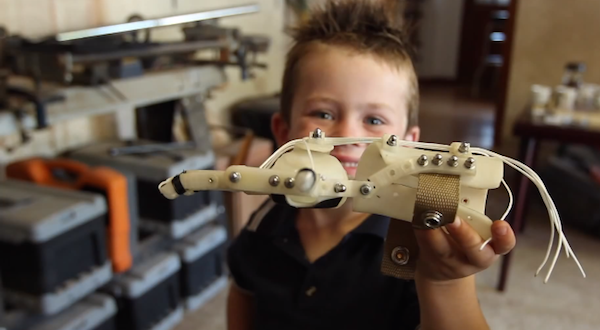
Guest author Ben Millstein is a copywriter at MakerBot who’s passionate about crowdfunding tools like Indiegogo, which empower the next generation of independent creatives. Here, he shares his thoughts on 3D printing and how it can enhance crowdfunding campaigns.
You’ve probably seen a 3D printer before, whether on TV or thanks to inspirational Indiegogo campaigns like Robohand. Sure, the technology seems miraculous, but 3D printing can help Indiegogo’s community of makers become dynamic inventors and entrepreneurs.
Here are four ways you can use a desktop 3D printer to take your Indiegogo-powered project or product to the next level:
1. FUNCTIONAL PROTOTYPES
If it’s solid plastic functional prototypes you’re after, a desktop 3D printer is the perfect tool to bring it to life.
Engineers and product designers can rapidly iterate on a complex gear, lever, or case for hardware, ensuring that the design meets their standards before investing in the final production-quality component. Inexpensive 3D printed prototypes have reached a threshold of quality that allows them to act as stand-ins for the final part.
For example, many of the systems used by famed engineering firm Lockheed Martin in creating NASA’s James Webb Space Telescope go through lengthy cryogenic testing to make sure the machinery holds up in the freezing vacuum of space. In fact, some of the final parts have to spend over 24 hours spinning in a vacuum. 3D-printed prototypes give the Lockheed Martin team the ability to test the functionality of parts while the actual metal components whirl in the extreme cold.
2. ELEGANT DEMOS
Need to 3D print something in a hurry? Use a low-resolution setting to create a quick demo your coworkers and clients can see and feel. The flexibility of desktop 3D printing makes demonstrations fast and easy.
In a recent interview, W. Scott Allen, an associate architect and designer for Perkins+Will, a global architecture firm that uses 3D printing, said many clients find it easier to give feedback and suggestions on a design by holding a 3D-printed object, as opposed to computer models that have dominated architectural demos in the past.
“The earlier you can look at a physical object, the sooner you can understand a building and also make better design decisions,” said Allen.
3. CUSTOMIZED OFFERINGS
From simple cell phone cases to complex prosthetics, desktop 3D printing gives product designers the opportunity to create customized products for their end users.
Take Indiegogo-backed UCreate3D’s custom cases for tablets and smartphones. The company’s phone cases offer modular, switchable back panels that you can personalize using free online design software. It exceeded its funding goal by over $5000.
4. BRANDING OPPORTUNITIES
While desktop 3D printing offers lots of tangible benefits for your business, it’s important not to overlook one simple fact: 3D printing is just plain cool. If you’re a brand looking to capture your customers’ imaginations, 3D printed gifts are a great way to turn potential investors’ and customers’ heads.
Famed retailer Saks Fifth Avenue recently used desktop 3D printing to make a splash in their midtown Manhattan location during the holidays, giving away beautiful 3D printed snowflakes inspired by the work of artist Marian Bantjes.
To help you start innovating and incorporating 3D printing into your crowdfunding campaigns, we’d like to give you a special deal on the MakerBot Replicator 2 Desktop 3D Printer from MakerBot.
One Response
You must be logged in to post a comment.



F-EYE Shoppy makes all types of the power bank such as power bank or battery charger,portable mobile charger and solar mobile charger,power bank 10000mah etc.
——————-
https://feyeshoppy.com/10000mah-power-bank